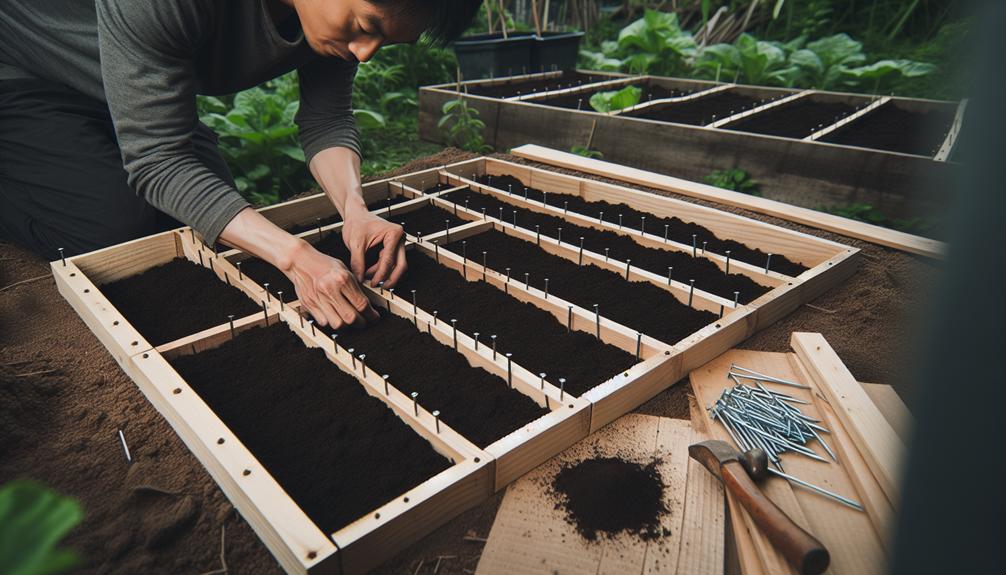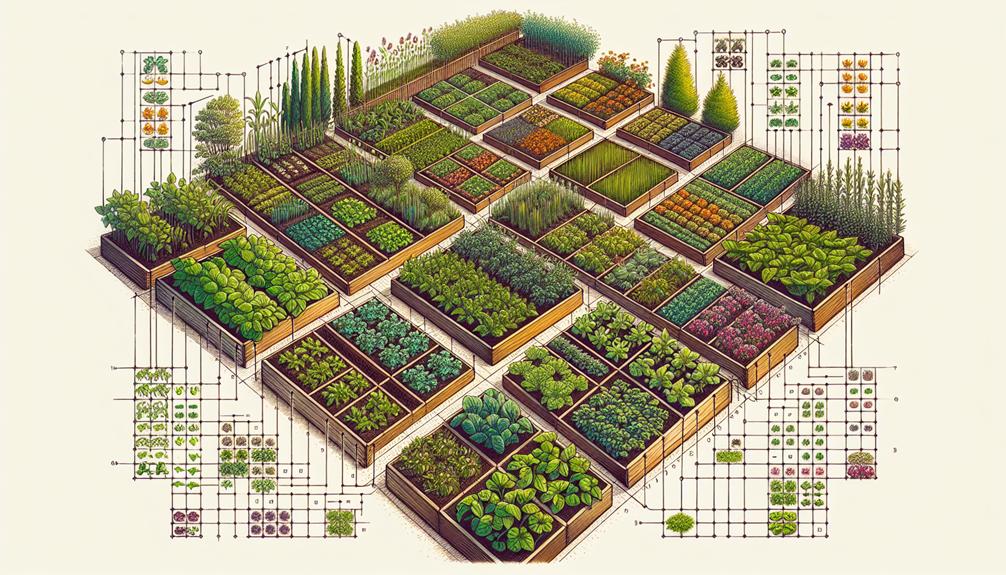You’ve been wanting to start your square foot garden, but you’re not quite sure where to begin.
The key to a successful square foot garden lies in the grid that divides the planting area into manageable sections.
But how do you go about crafting the perfect grid for your garden?
Well, it all starts with selecting the right materials and tools, and that’s where we come in.
Let’s explore the essential steps to creating a functional and efficient square foot gardening grid that will set the stage for a bountiful harvest.
Choosing the Right Location

When selecting the optimal location for your square foot garden, consider choosing a spot that receives at least six to eight hours of direct sunlight daily. Sunlight exposure is crucial for the healthy growth of your plants.
Once you’ve found the perfect spot, it’s time to prepare the soil. Start by testing the soil’s drainage. Dig a hole about 12 inches deep and fill it with water. If the water drains within 24 hours, the soil has good drainage. If not, you may need to amend the soil with organic matter to improve drainage.
After ensuring good drainage, focus on soil preparation. Mix in compost to improve soil structure and fertility. This will provide essential nutrients for your plants. Additionally, consider adding organic matter to help with water retention and aeration, ensuring your plants have access to the moisture and oxygen they need to thrive.
Pest control is another factor to keep in mind when choosing the location for your garden. Look for signs of pests in the area, and if necessary, take preventive measures to protect your plants.
Gathering Materials and Tools
Now that you’ve selected the perfect location for your square foot garden and prepared the soil, it’s time to gather the materials and tools you’ll need to get started.
Here’s what you’ll need:
- Lumber: Purchase untreated lumber to build the frame for your square foot garden. A 4×4-foot frame is suitable for beginners, and you’ll need enough lumber to construct the desired number of frames based on the size of your garden area.
- Measuring Tape and String: These tools are essential for creating the grid layout within each frame. Use the measuring tape to mark off the 1-foot sections and the string to create the grid lines both horizontally and vertically.
- Mel’s Mix: As a crucial part of the square foot gardening method, this soil mix consists of one-third compost, one-third peat moss, and one-third coarse vermiculite. Purchase these ingredients in the required quantities based on the size of your garden.
- Hand Trowel and Watering Can: These basic tools will be your best friends throughout the gardening process. A hand trowel is perfect for planting seeds and seedlings, while a watering can helps you evenly distribute water without disturbing the grid layout.
Gathering these materials and tools will set you up for success as you embark on your square foot gardening journey.
Building the Grid Structure

To build the grid structure for your square foot garden, begin by assembling the untreated lumber into the desired frame size, ensuring each corner is securely joined. Consider using 1×6 or 2×6 untreated lumber for the frame, as they’re durable and resistant to decay.
When selecting the grid spacing, keep in mind the mature size of the plants you intend to grow. For larger plants, like tomatoes or peppers, a grid spacing of 12 inches is suitable, while smaller plants such as lettuce or radishes can thrive with a 6-inch grid spacing.
To ensure the durability of the grid structure, use exterior-grade screws or galvanized nails to secure the corners and any additional support in the middle of longer sides. This will prevent warping or shifting over time, especially when the soil is added and the garden is in use.
Additionally, consider adding a coat of non-toxic wood sealant to protect the lumber from moisture and prolong its lifespan.
Planting Your Crops
For optimal growth in your square foot garden, carefully plan and space out the placement of your crops to maximize their health and yield. When it comes to planting your crops, following the right techniques and being mindful of soil preparation and watering methods is essential. Here’s how to do it:
- Crop Selection:
Choose crops that are suitable for the size of your square foot garden and consider companion planting to maximize space and yield. Select a variety of vegetables and herbs that thrive in the conditions of your garden.
- Planting Techniques:
Follow the recommended spacing and depth for each crop. Take into account the mature size of the plants when spacing them to avoid overcrowding. Utilize trellises or cages for vining plants to save space and improve air circulation.
- Soil Preparation:
Ensure the soil is well-draining, nutrient-rich, and free from debris. Mix in compost or organic matter to improve its structure and fertility before planting. Consider using raised beds to further control soil quality.
- Watering Methods:
Implement a watering schedule that suits the specific needs of each crop. Utilize drip irrigation or soaker hoses to deliver water directly to the roots and minimize evaporation. Regularly monitor soil moisture to avoid under or overwatering your crops.
Maintaining and Managing Your Grid

Once your crops are planted and thriving in your square foot garden, maintaining and managing your grid becomes essential for sustaining their health and maximizing your yield. Proper soil preparation is crucial for ongoing success. Regularly replenish your soil with compost to ensure it remains rich in nutrients.
Consider using a moisture-retaining mulch to help regulate soil temperature and reduce water evaporation. When watering, aim to keep the soil consistently moist, but not waterlogged, to support healthy plant growth.
Pest control is another key aspect of grid maintenance. Inspect your plants frequently for signs of pests and disease, and take swift action to address any issues. Consider using natural pest control methods such as companion planting or introducing beneficial insects to your garden. Additionally, incorporating crop rotation into your maintenance routine can help prevent the build-up of pests and diseases in the soil.
Regularly tending to your square foot garden will ensure that your plants continue to thrive. By implementing these soil preparation, watering, pest control, and crop rotation techniques, you can maintain a healthy and productive grid throughout the growing season.

